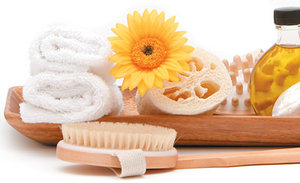A cup of white vinegar in the laundry will soften clothes. Essential oils like lavender, eucalyptus and tea tree will kill bacteria and viruses in cold- and hot-water wash. Put the essences into the vinegar and add to the wash-cycle water. Studies have shown that eucalyptus eliminates all but the tiniest fraction of dust mites known to survive a "normal" laundering experience.
Combine water and eucalyptus in a mister and spray your mattress, pillows, bedspreads, dust ruffles, curtains and upholstered furniture to eliminate dust mites and other unwelcome organisms. Spray this same mixture into the intake vent of air conditioning and heat systems. In a large spray bottle, use a cup of white vinegar and 30 drops each of lavender and tea tree. Shake, then top off with water. Use this to spray the shower and shower doors and to clean surfaces. Studies have shown that lavender and tea tree together are more effective than the chemicals in antibiotic soaps. Vinegar will leave shower doors clear and sparkling.
A Few Resources
For more information on essential oils and carrier oils for skin types, read The Aromatic Spa Book, by Sylla Sheppard-Hanger. Donna Maria's Making Aromatherapy Creams and Lotions has lots of great recipes that combine essential oils with fruits and foods.
History of Aromatherapy
Not much was heard about aromatherapy in the United States until the 1990s, although the use of fragrant essential oils for health and beauty care goes back to the beginning of our relationship with plants. From ancient times, aromatherapy flourished in the Middle East, India and China. Secrets about extraction methods, along with the precious oils themselves, made their way to Europe through expanded trade routes and soldiers returning from the Crusades. Essential oils and the herbs and spices that were the medicines of the time lost ground with the advent of microscopes and the ability to isolate and make a synthetic form of a plant's active ingredients.
 In the early 1900s, a French chemist named René-Maurice Gattefossé was badly burned while working in his cosmetics lab. He knew the old lore that recommended lavender for healing burns. In a state of emergency, he used the pure essential oil of lavender that was at hand. Amazed at how rapidly his injury healed without complications, he turned his microscope to the investigation of the healing properties of aromatic plants and coined the term Aroma Therapie. Today, a medical student in France can specialize in aromatherapy. Essential oils are regulated by a government agency and the properties and uses are well-researched and documented. However, there is currently no U.S. regulation of essential oils in terms of practice or products. For this reason, it is good to get an education in proper use of essential oils through reputable books and classes. (The National Association for Holistic Aromatherapy is a good resource for both. You can contact them at www.naha.org.)
In the early 1900s, a French chemist named René-Maurice Gattefossé was badly burned while working in his cosmetics lab. He knew the old lore that recommended lavender for healing burns. In a state of emergency, he used the pure essential oil of lavender that was at hand. Amazed at how rapidly his injury healed without complications, he turned his microscope to the investigation of the healing properties of aromatic plants and coined the term Aroma Therapie. Today, a medical student in France can specialize in aromatherapy. Essential oils are regulated by a government agency and the properties and uses are well-researched and documented. However, there is currently no U.S. regulation of essential oils in terms of practice or products. For this reason, it is good to get an education in proper use of essential oils through reputable books and classes. (The National Association for Holistic Aromatherapy is a good resource for both. You can contact them at www.naha.org.)

